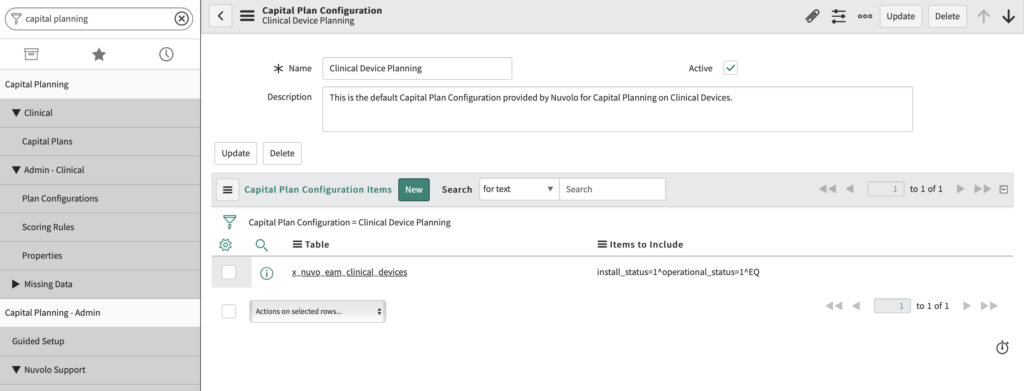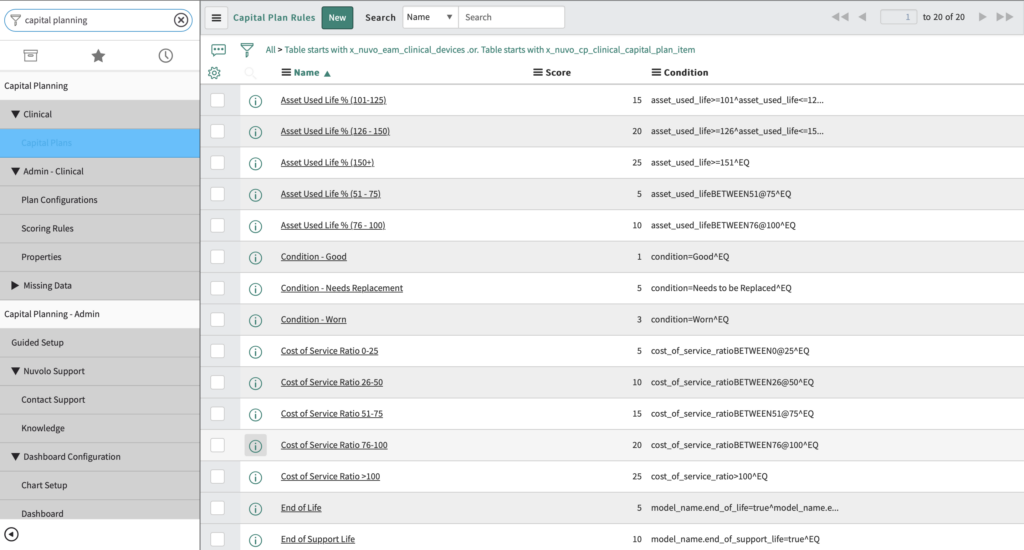3 Ways to Address Capital Planning in a Post-COVID World
- Capital Planning in a Post-COVID World
- 1. Reduced Capital Budgets
- 2. Capital Needs Prioritization
- 3. Managing Risk
Capital Planning in a Post-COVID World
Post-COVID, hospitals and healthcare systems are recovering from the financial strain of 2022 and facing ongoing challenges in 2023 due to inflation, high labor costs, volatile markets, new legislation, new patient value-based strategies, and supply chain issues. These pressures are driving healthcare facilities to look for new ways to streamline workflows and find efficiencies—especially when it comes to capital expenses, which account for a large portion of a hospital’s typical operating budget.
With so much on the line—and pressure to keep costs down—asset capital planning can become a stressful, complicated process. But there are ways to simplify the process and address the challenges head-on. We’ve identified the three biggest pain points and ways to overcome them for positive results.
The Current Situation: Balancing Resources and Demands
The healthcare industry continues to suffer from massive financial strain as a result of the pandemic, which has led to reduced budgets for capital projects. Instead of investing in new capital projects, hospitals and health systems have had to make up for lost revenue and address additional challenges, including:
- Shifting resources to pandemic response
- Canceled or postponed elective procedures
- Higher operational costs, driven by increasing prices for medical supplies and pharmaceuticals
- High labor costs to keeping skilled clinicians and administrators
- Labor shortages from burnt out workers
Supply chain issues, including delays and shortages
Beyond post-pandemic woes, the healthcare industry also needs to account for external factors, such as government influence and regulations.
Reimbursements, which the healthcare industry relies on to stay afloat, are decreasing due to budget constraints (payer profit pools were forecasted for an 11% annual growth rate from 2021 to 2026 but will be slower in 2023). Plus, providers are shifting away from fee-for-service to value-based care, in which they offer cost-effective care that results in being more patient-focused, including being mindful of costs to the patient. The patients benefit, but this also means less revenue and contributes to more conscious capital spending.
Compliance with legislative requirements in healthcare capital forecasting is always an influential factor. However, the pandemic gave way to legislation such as the CARES Act that accelerated telehealth. It also gave way to healthcare waivers (increasing flexibility for healthcare providers to treat patients off the hospital site), which offered to support the pressures brought on by the pandemic. These new business models are still relevant today. They are pushing healthcare systems to invest in alternative care sites or home-based care models rather than existing sites, causing more pressure on capital budgets.
These factors mean you’ll need to adjust your long-term plans, work closely with team leaders, and wait longer for approvals. Even after all this, you may still need more data to understand your budget needs.
Desired Outcome: Get Leadership & Finance to Approve Your Capital Budget
Every capital planner customer we engage with tells us their goal is to get the most out of their assets, align themselves with clinician and department stakeholders’ goals, and communicate why their single or multi-year capital budget needs approval. They view themselves as more of a partner that adds value rather than a separate department with different goals. Before the pandemic, getting budget approval to replace equipment was straightforward and usually cleared on the first attempt. But now, things have changed. Capital planners need multiple attempts and more detailed information to get the green light. The challenge is even more significant when they rely on spreadsheets filled with outdated data for their approval requests. This situation frustrates them. They feel they can’t effectively serve their stakeholders and patients.
Enter Nuvolo’s Capital Planning solution—a powerful solution designed for HTM asset capital planners using critical asset data and industry-specific insights; our solution simplifies the creation of comprehensive multi-year plans out of the box, allowing you to align your strategies with financial goals while considering macro-environmental factors, reimbursement, and compliance.

Current Situation: Prioritization Overload
In the wake of COVID-19, healthcare facilities are grappling with the challenge of prioritizing capital expenditures. Inherently complex to gain stakeholder alignment, this task has been further complicated by adding post-pandemic economic variables: inflation, supply chain disruptions, and consumer and operation model shifts.
As the economy bounces back, inflation has seeped into the healthcare industry, driving up the cost of equipment, services, and construction. Capital planning teams must steer through these financial waves and make intelligent decisions. A high expense today could mean a budget crisis tomorrow. Healthcare leaders, without the help of technology for efficiency, are feeling the pinch. Due to inflation, their profit margins shrink, sometimes by 25 to 75 percent.
Simultaneously, persistent supply chain issues pose another significant challenge. Global trade disruptions, labor shortages, and raw material scarcity have resulted in unpredictable availability and increased costs of essential assets. Because of this, capital planning can become a juggling act between ensuring continuity of care and supporting financial sustainability.
While these supply chain challenges already put enough strain on capital planning, the pandemic’s impact on the healthcare landscape has added another layer to this complex issue with a shift towards addressing the entire health journey of patients (population health). This drive towards improved affordability, quality, accessibility, and patient experience has led to models that favor shifting from high-cost acute and post-acute sites to lower-cost freestanding and non-acute sites. These models generate more revenue and have lower cost margins, making them desirable for healthcare players. However, as great as this model is and prioritizes patient care, it creates a challenge for capital planners in deciding whether to give the capital budget to existing but less utilized acute medical devices (which are more expensive) or non-acute sites with higher use (lower cost than acute medical devices).
Desired Outcome: Reduced Guesswork
As we move into 2023 and beyond, the critical task for healthcare facilities is to streamline capital planning in alignment with their strategic goals. It requires a comprehensive understanding of asset needs, a balanced consideration of risk and performance factors, and clear visibility for leadership and unit teams. Executives at tech-enabled organizations are expecting that payers and providers will rely more heavily on technology to promote efficiency. These executives said they expected a drop of about 15 to 50 percent compared to the 50 to 75 from non-tech enabled healthcare systems.
Nuvolo’s Capital Planning solution helps transform reactive and subjective decision-making into data-driven insights that align with your organization’s goals. It revolutionizes the approach to capital planning by integrating an intelligent scoring algorithm. This system examines live asset and facility condition data, considering age, condition, risk, and performance parameters. It ranks and prioritizes asset needs, delivering a clear, data-driven plan for capital expenditure.

Current Situation: Risk to Patients & Risk to Clinical Outcomes
Insufficient budgets, uncertain prioritization, and reliance on outdated capital tools like spreadsheets often lead to reactive capital planning. As a result, data capture is incomplete, clinical departments do not meet industry standards, and the risk to patient safety increases.
However, patient safety is still of utmost importance. Unfortunately, incomplete or outdated data collection methods can create gaps in identifying and addressing risks. These risks can range from medication errors to equipment malfunctions and operational inefficiencies. Failing to address these risks promptly puts patients at risk and affects healthcare organizations’ reputations and financial stability.
Similarly, for healthcare providers, top-quality results are essential. Seeing all relevant data helps identify trends, patterns, and potential risks. If data capture is lacking, it affects process improvement and adherence to best practices, leading to less effective patient care. Healthcare organizations can ensure patient safety and improve results by enhancing data capture.
Desired Outcome: Value-based Care & Supporting Your Clinical Teams
Your goals are straightforward: 1) ensure your patients are safe; and 2) support your medical teams under all conditions to foster a reliable healthcare establishment. A satisfied staff with the right resources for top-notch care is vital. A healthy environment makes patients feel valued and appreciated. To achieve this aim, all necessary information must be readily available.
Nuvolo’s goal is to help keep patients safe and simplify capital planning. We offer a tool that collects and shows all the important data in one place. This helps manage risks and make smart decisions. Users can also create their own surveys to gather more information about their assets, giving a complete picture of their situation.

Despite the challenges faced by healthcare asset planning teams in 2023, partnering with the right technology solutions can streamline workflows, mitigate risks, and perfect asset capital planning.
To learn more, visit Bringing Facilities Condition Assessments into the Digital Age.
Bringing Facilities Condition Assessments into the Digital Age
Learn More